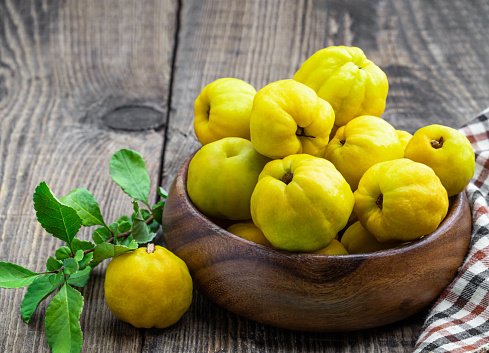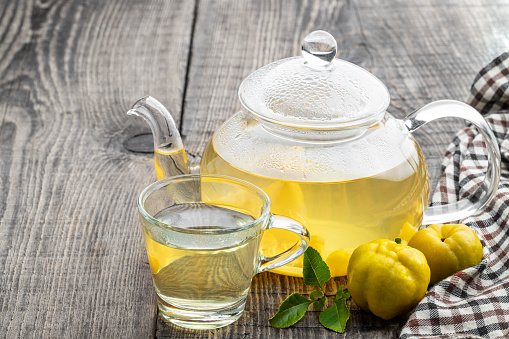Good afternoon, this is Angela with Parkrose Permaculture. I am standing in the side yard of my Portland, Oregon permaculture garden. We are in zone 8b, and it is Michaelmas, so today is the day when I’m starting to harvest my quince. I have had a little bit of windfall quince in the last few days, and I made a batch of quince jam. I will include the recipe down below—it’s one of my favorite jams. But now, I need to get serious about picking the rest of the quince, so I thought I would talk you through my process of how to know when quince are ready to harvest, as well as discuss why quince is such a great fruit for a permaculture garden, a home orchard, a cottage garden—you name it. I think you cannot go wrong with the quince (Cydonia oblonga).

The quince is a fruit that I think is much underappreciated and underutilized in North America. It is such a beautiful, hardy tree with a gorgeous shape. I made an article this spring—you can check out the link here—where I show the quince in flower. It has beautiful, delicate pink blossoms that have a lovely aroma. It’s a really ornamental, decorative tree in any garden. The quince is self-fertile, so you only need one to get fruit. The quince fruit is definitely reminiscent of an apple or a pear in shape—you can tell it’s a pome fruit. It is really unique, though—it’s very, very hard, and you can’t eat it raw. Well, there are a few varieties you can eat raw, but it’s kind of like eating lemonade in super crunchy form. I don’t particularly enjoy the kinds that you can eat raw, but when you cook a quince, it transforms entirely. You get this very hard, rock-hard fruit; it softens, the flesh inside turns a pale pink, and it gives off the most unbelievable kind of floral, almost tropical fragrance. The smell of roasting quince perfumes the entire house, and the fruit itself, I feel, is more complex than a pear, more complex than most varieties of cooking apple. It has a kind of spiciness, a floralness, and a depth to the cooked fruit that I can’t compare to anything else. It would not do the quince justice to say that it’s very similar to an apple or a pear—it is its own unique fruit and has its own special place in the home garden, both for the flowers and the food production, and also in the kitchen. Its culinary use in the American kitchen is sorely neglected, and I think that we would all be more resilient and more expansive eaters if we were to grow and use the quince in our home gardens more.

Okey-doke, this is the smaller of my two quince. I used to have five quince, but I have reduced the number down to two because it’s just way more fruit than I can handle. You can see the branches are weighed down with the fruit. A quick little note here: quince are mostly tip-bearers, so you see how all of the fruit is produced on the ends of the branches. They fruit and flower best on the ends of newer wood, so I try to go in and remove the oldest wood every year, about a fifth to a quarter of it. But do be aware that if you do harsh winter pruning on your quince, you may reduce your fruit production for the next year. The quince has this fuzzy coating on it, almost like a peach, but it comes off. You’ll see here the ones that are in the walkway that we’ve brushed against as we’ve tried to get through have all of the fuzz rubbed off. It doesn’t harm the fruit to remove it—you can see these have still ripened nicely. But you do want to wash and remove that fuzz before you cook your quince.
So, the quince itself—when you are looking at it and saying, “How do I know whether it’s time to harvest or not?”—there are a couple of tips that I go by, a couple of markers that I go by. The first one is: is it turning from green, like this one, to kind of a spring green turning to yellow? So, let me pick this one here, and I’ll compare for you. See the difference? Not quite ready yet. Ready. And these are on the same bush—this one out here gets more sunshine, and this one is a little more tucked in. So you will find that you don’t want to pick all your quince in one day if you can help it—they will ripen over the course of a couple of weeks. Now, one thing to note is that if your quince is still partially green and you happen to pick it, or the wind happens to knock it off, it will continue to ripen on the counter like this one. So don’t worry if you have to pick all of your tree at once or if you have windfalls—they will continue to ripen on the counter.
So the first marker is: is it starting to turn yellow? The second marker is: come in and give a deep inhale and smell the aroma of the quince. It gets very fragrant when it’s ripe. In fact, when you pick a bowl of these and put them in the kitchen, they will fill the entire downstairs of your house with the smell of quince. So if you smell that really aromatic scent, you know that they’re getting ripe. The third marker is: when you lift the quince, does it come off easily, much like a pear or an apple? That is an indication of ripeness when this abscission layer in here between the quince and where it attaches to the tree separates easily. Okay, that came off really nicely. Let me show you this one, though—I’m really twisting, and the whole stem here is bending with the fruit; it does not want to come free. That is not ready. But if you lift the fruit up and it snaps, it’s ready. Let’s try this one. Lifting—it came off very easily, so that one’s ready to pick.
Here you can see my large quince tree. Now, quince can be trained as a bush or a tree—I really prefer having it as a bush. It makes it much easier to reach the fruit. Not only that, but quince, despite the fact that they are rock hard, bruise really easily. And so when you have them as a bush, they don’t have to fall as far to hit the ground. One sign of ripeness—oh, this one is really fragrant—one sign of ripeness is that they fall off the tree if it’s windy out. So if you’re going to grow your quince as a tree, I really encourage you to have a good, thick layer of wood chips underneath to cushion the quince as they hit the ground. But also, you can see I have some up here that are just really difficult to reach. This quince is going to get a really big prune—here you can see last week I started pruning it. These will get chipped up in a little bit. Quince is very hard wood, and it makes excellent firewood, by the way—very, very, very hard.
So I’ll pick the rest of these—I picked most of these the other day, but the ones that are way up high I’m going to try and cut the whole branch down and then pick them, so it’s a prune and a pick at the same time. But really, if we pan over here—but really, I personally think that the quince is much, much easier as a heavily harvestable crop if it is trained six feet or shorter. Again, you can see there’s going to be a couple of hundred pounds of fruit off of this one plant. Lots of folks have noted that the quince produces about twice as much fruit per tree as an apple—so just tons and tons and tons. Again, I started out with five quince; I’m down to two because it’s just too much fruit. But don’t worry—again, home gardener, you only need one to get fruit, and you’ll get more than you can possibly use.
Now, the quince itself does not actually have that long of a shelf life, so you want to make sure that you have the time in your schedule to put up the harvest. It’s a really hard fruit, but it doesn’t last that long. It will keep much longer if you have a drawer in your refrigerator you can dedicate to part of your quince harvest. You can slice and dehydrate the quince, you can make sauce out of it, and it freezes very well. You can make membrillo, quince paste, also called quince cheese, and you can make jam. Now, quince is incredibly high in pectin, so you don’t need to add pectin when making jam. Again, check out my recipe down at the bottom—it’s one of the reasons that quince is a great fall addition to any other jam that you’re making. Don’t have commercial pectin on hand? Mix in a significant portion of quince with your other berries, and you will get your jam or jelly to set really nicely. Quince is also fantastic roasted. Again, it turns pink when you roast it—any combination of root vegetables that you’re going to roast and enjoy, anything like a dish that’s nut-based, is going to go really well with the aromatic notes of a quince. It’s also fantastic with poultry or roast pork if you enjoy those foods.
So, thank you for watching. I hope you got something out of this article. I hope that you are learning a little bit more about permaculture and resilient gardening every time you check in with this channel. I will have lots more in the coming weeks from the garden—we are really cranking up the fall harvests. So I will be picking all of these quince, and we have a new little farm stand that I’m putting out on the corner, and I think a bunch of these will be going out in our pay-what-you-can farm stand because there will probably be a couple of hundred pounds from both of my trees, and it’s going to be far more than I can use. So, if you’re in the Parkrose neighborhood, you might check out our farm stand. For folks who want to support this channel on a regular basis or even just a one-off time, I have a Patreon and a PayPal down in the description. But don’t feel any pressure to contribute in that way—I just appreciate you watching and hope that you are getting something out of these articles. Thanks!